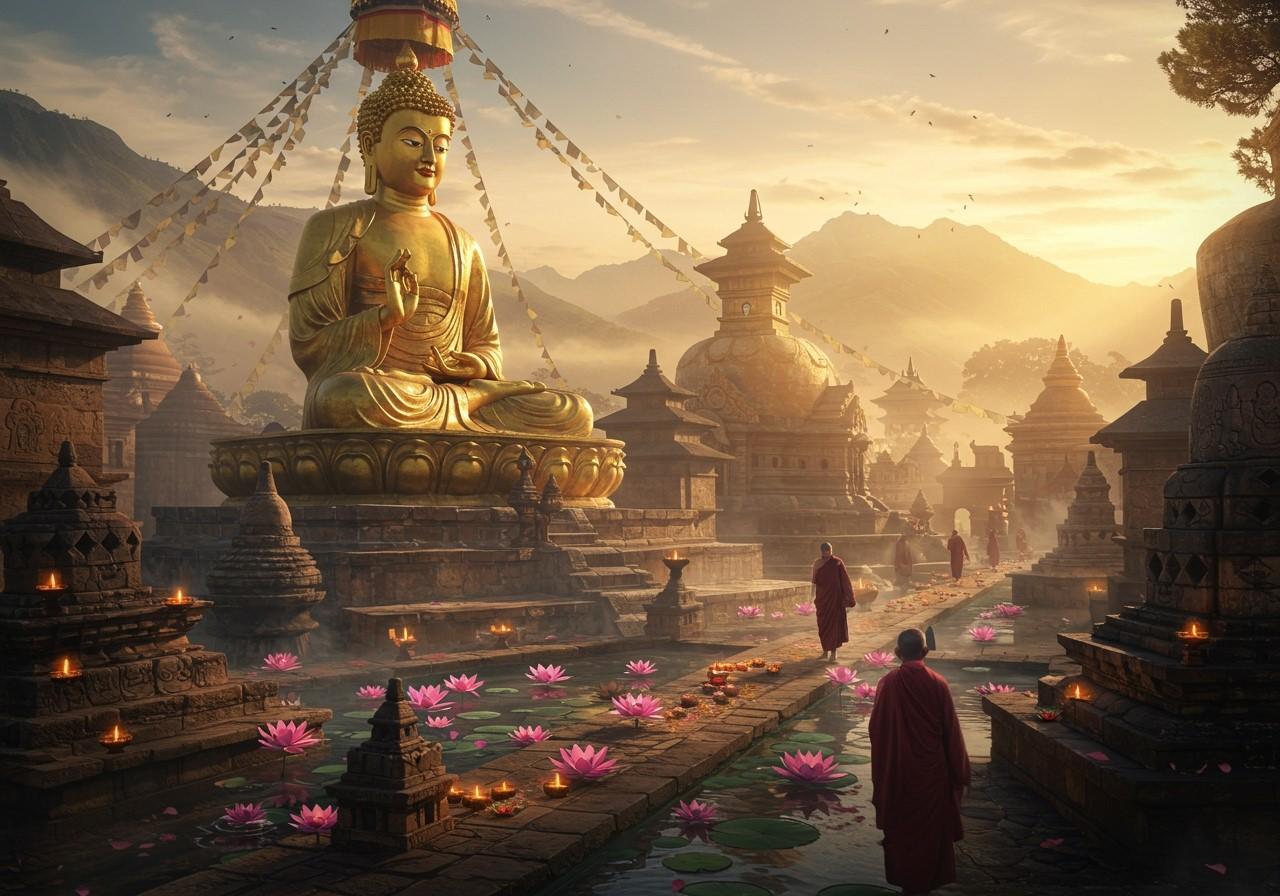Travel
Exploring the Vibrant Buddhist Festivals of India: A Journey Through Spirituality and Culture

India, the birthplace of Buddhism, is home to a rich tapestry of Buddhist culture and traditions. Over the centuries, Buddhism has flourished across the country, and its festivals are a vibrant reflection of its philosophy and spiritual teachings. Buddhist festivals in India offer a unique opportunity to explore the deep connection between the spiritual and cultural life of the people, while celebrating key moments in the life of Lord Buddha and the broader Buddhist tradition. These festivals bring together monks, devotees, and travelers, creating an atmosphere of peace, reflection, and joy.
Whether you’re a spiritual seeker or someone interested in cultural exploration, experiencing these festivals in India will provide insight into the timeless teachings of Buddhism and its significance in modern life. Here are some of the most popular Buddhist festivals in India, celebrated with grandeur and devotion.
1. Buddha Purnima – The Most Sacred Buddhist Festival
One of the most significant and widely celebrated Buddhist festivals in India, Buddha Purnima marks the birth, enlightenment, and death (Mahaparinirvana) of Lord Buddha. It is celebrated on the full moon day in the month of April or May, and it is a day of great importance for Buddhists worldwide.
The most important event during Buddha Purnima is the Buddha Jayanti, which commemorates the birth of Lord Buddha in Lumbini (Nepal). On this day, temples, monasteries, and stupas are beautifully decorated with flowers, candles, and incense. Buddhists gather in temples for prayers, chanting, and meditation to honor Lord Buddha’s teachings and seek spiritual guidance.
In India, significant celebrations take place in places like Bodh Gaya (where Buddha attained enlightenment), Sarnath (where he delivered his first sermon), and Kushinagar (where he attained Nirvana). Thousands of pilgrims visit these sacred sites to participate in the religious activities and meditate on Buddha’s teachings of peace and compassion.
2. Lhabab Duchen – The Buddha’s Descent from Heaven
Lhabab Duchen is one of the important Buddhist festivals in India, particularly celebrated by Tibetan Buddhists. It marks the day when Lord Buddha descended from the heaven of Tushita, after teaching his mother and other deities the Dharma. This festival usually falls in the month of October or November, based on the Tibetan lunar calendar.
On this day, Tibetan Buddhists in India, especially in areas like Dharamsala and Tawang, engage in prayers, meditation, and the recitation of sacred texts. Monasteries organize special pujas, and devotees offer prayers to Buddha, expressing gratitude for his teachings. The festival emphasizes the theme of compassion and the Buddha’s selfless act of teaching the Dharma to all beings, including gods and humans.
3. Saga Dawa – Celebrating Buddha’s Birth, Enlightenment, and Death
Saga Dawa is another important Buddhist festival, primarily celebrated by Tibetan Buddhists in India. It is observed on the 15th day of the fourth lunar month, which usually falls in May or June. This festival is significant as it commemorates the birth, enlightenment, and death (Mahaparinirvana) of Lord Buddha in a single event. The entire month is considered highly auspicious, with the 15th day being the peak of the celebrations.
In monasteries and Buddhist communities, Saga Dawa is marked by processions, prayers, and meditation. Devotees make offerings, engage in charitable acts, and practice virtuous deeds to accumulate merit. In areas like Dharamsala, Sikkim, and Ladakh, the festival is celebrated with fervor and devotion, attracting pilgrims who come to participate in the religious activities.
4. Buddha Jayanti – A Day of Reverence
Buddha Jayanti is a special celebration observed in India to honor the birth of Lord Buddha. This festival is closely linked to Buddha Purnima, as both commemorate the same event—the birth of Buddha—but Buddha Jayanti is often celebrated with greater focus on the life and legacy of Lord Buddha. It usually takes place in the month of April or May, coinciding with the full moon.
In India, Buddha Jayanti is marked by colorful processions, religious gatherings, and the decoration of Buddhist temples. In cities with significant Buddhist populations, like Ladakh and Dharamsala, celebrations include rituals, prayers, and chanting of sacred texts. Pilgrims visit monasteries and stupas to honor Lord Buddha and reflect on his life’s teachings. In some places, the day is also marked by the release of birds and animals as a symbol of compassion and non-violence.
5. Chhewar Ceremony – The Buddhist Rite of Passage
While not as universally recognized as other Buddhist festivals in India, the Chhewar Ceremony (also known as the Buddhist Upanayana or the sacred thread ceremony) is an important event for young Buddhists in India, particularly in regions like Ladakh and Sikkim. This ceremony is similar to the Hindu “Thread Ceremony,” where a young boy is initiated into the study of the Buddha’s teachings.
During the ceremony, the boy is given a mani (prayer wheel) or a sacred thread, signifying his entrance into the Buddhist community and his commitment to following the Buddhist path. The ceremony is followed by prayers, chants, and blessings from the monks. This tradition is highly revered and symbolizes the spiritual growth and commitment of the individual to Buddhism.
6. Losar – Tibetan New Year Celebrations
Losar, the Tibetan New Year, is one of the most vibrant Buddhist festivals in India, especially celebrated in the Tibetan Buddhist communities of Dharamsala, Tawang, and Ladakh. This festival marks the beginning of the new year according to the Tibetan lunar calendar, usually falling in February or March.
Losar is a festive occasion, with celebrations lasting for several days. The festival includes prayers, rituals, and feasts, as well as traditional Tibetan dances and music. Homes are cleaned and decorated with religious symbols, and families gather to offer prayers for health, prosperity, and happiness in the coming year. It is a time to honor the Buddha and express gratitude for his teachings, while also strengthening bonds with family and community.
7. Monlam Prayer Festival – The Festival of Prayers
Held in various Tibetan Buddhist monasteries in India, particularly in Dharamsala, the Monlam Prayer Festival is a highly significant event that focuses on prayers for the well-being of all sentient beings. The festival is part of the Tibetan tradition and is often organized around the new year period, but it can be observed on different dates depending on the local monastery’s calendar.
During the festival, monks engage in Monlam, which involves the recitation of prayers and mantras, often for peace, prosperity, and spiritual awakening. The event draws large crowds, as it’s not only a spiritual celebration but also an opportunity for people to come together and make offerings for the welfare of humanity.
Conclusion
Buddhist festivals in India are not just occasions for celebration; they are also opportunities for deep spiritual reflection, community bonding, and honoring the teachings of Lord Buddha. These festivals highlight the timeless values of peace, compassion, mindfulness, and wisdom that Buddhism stands for. Whether it’s the grandeur of Buddha Purnima in Bodh Gaya or the festive joy of Losar in Dharamsala, participating in these festivals is an enriching experience that offers both cultural immersion and spiritual growth.
For those interested in learning about Buddhism or experiencing its traditions, attending these festivals is a beautiful way to connect with the teachings of the Buddha and the vibrant communities that continue to honor his legacy. So, mark your calendars, plan your trips, and immerse yourself in the celebration of peace, compassion, and enlightenment that these festivals bring to life.
